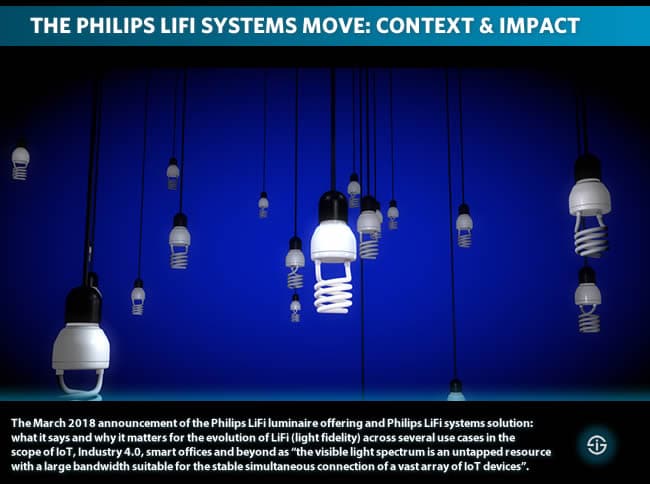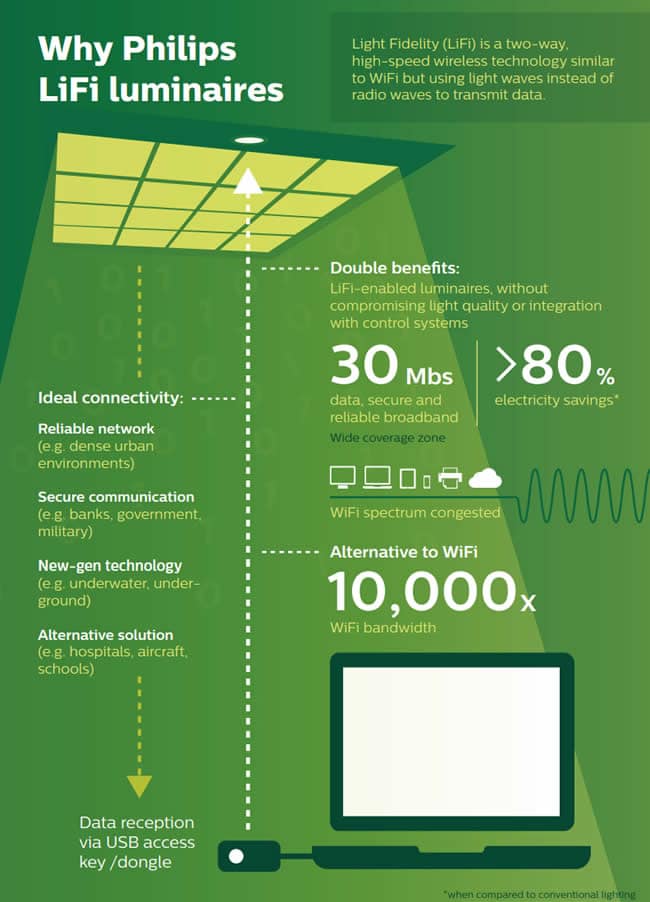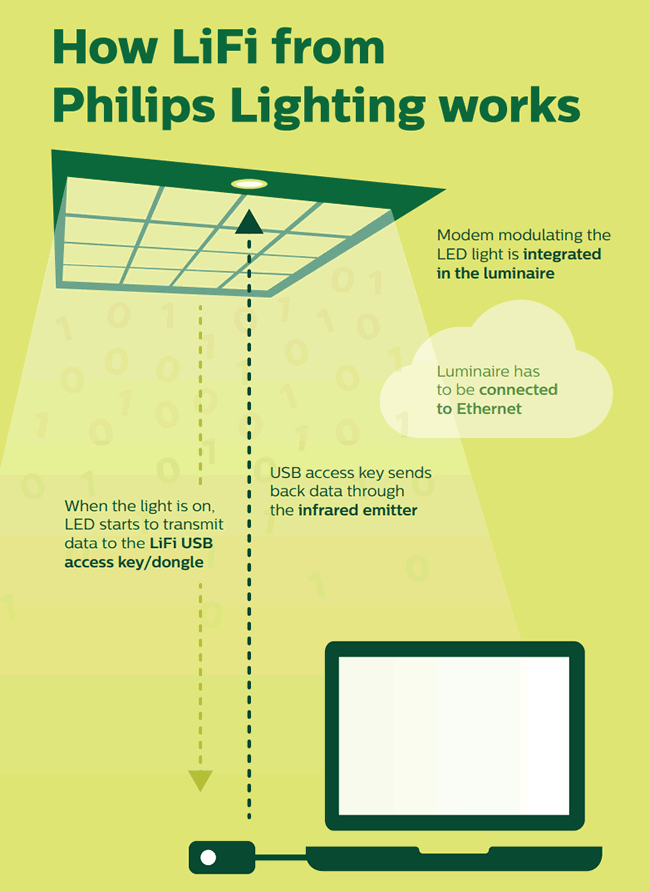The March 2018 announcement of the Philips LiFi luminaire offering and Philips LiFi systems solution: what it says and why it matters for the evolution of LiFi (light fidelity) across several use cases in the scope of IoT and beyond.
We haven’t heard too much about the famous spectrum crunch since several years. However, the need for spectrum keeps increasing.
It can’t be ignored that with ever more connected devices in the scope of IoT, intelligent building management, the connected workplace, Industry 4.0, smart manufacturing and smart ‘anything’ really, on top of our ever increasing usage of ample mobile devices with new form factors and devices there is growing attention for alternatives.
Add to that the ways radio frequencies are used, Wi-Fi congestion, ever more bandwidth-hungry applications (video), the need for more power (and energy efficiency) and you quickly encounter several benefits of LiFi. Add LiFi use cases such as the smart office (also think smart home automation or lighting and room control applications in, for instance, hotels) as being among those with clear benefits in the here and now with more players supporting LiFi (and conducting LiFi pilots) and you have some of the reasons why the announcement of Philips Lighting that it has a LiFi offering (Philips LiFi luminaires and what it calls Philips LiFi Systems whereby the lighting and LiFi are offered as an integrated solution) is pretty important. And there is more.

Before looking deeper quickly back to the (RF) spectrum crunch (it does come back). It’s, among others, in the spectrum crunch challenge that many advocates of LiFi are emphasizing some main benefits of their alternative: using the visible light spectrum (mainly LED) on top of and in some cases even as a replacement of communication technologies bases upon radio frequency with the spectrum challenge never having been really away and poised to hit us somewhere around 2025 according to LiFi pioneer Professor Harald Haas (who coined the term LiFi, applications of VLC or visible light communications with LED started before the term existed).
Philips LiFi as part of the bigger transformation LiFi is bringing in IoT use cases, Industry 4.0 and 5G
For Haas it’s always been clear: LiFi will transform the IoT, Industry 4.0 and 5G, which are poised to be held back by the radio frequency spectrum crunch.
LiFi technology and solutions have evolved a lot since the early days and many large companies are looking at these evolutions, from industrial giants such as GE and building and energy specialists such as Schneider Electric to companies such as Philips Lighting (soon to be rebranded with a new company name, Signify).
With ample use cases for LiFi and LiFi standardization efforts happening on various levels, Philips Lighting has now thrown its weight behind LiFi. In March 2018, the company announced its Philips LiFi offering, the first LiFi offering on such scale. While the initial focus seems to be the LiFi smart office market, Philips Lighting, on its “Philips LiFi systems solution” page and in its communications clearly points to more LiFi use cases in areas from healthcare and industry to government and corporate. Although some experts think that it is still early days for LiFi the significance of the fact that the global leader in lighting now comes with a LiFi offering should not be underestimated to say the least. This is even more so considering the clear educational and awareness-raising approach Philips Lighting has across its announcement material, from infographics to videos.

The clear commitment of Philips Lighting to LiFi, along with the support of LiFi from major companies such as Cisco, GE Lighting, Ericsson, Alcatel-Lucent and more (earlier this year also Wipro Lighting announced LiFi pilots), is a clear token that things might move fast, and not just in use cases in the scope of smart buildings and LiFi in smart offices but also in industrial applications and beyond.
The Fraunhofer Heinrich Hertz Institute (the Fraunhofer Institute for Industrial Engineering played and plays an instrument role in Industry 4.0), which did and does ground-breaking work on LiFi has three LiFi pilot installations in, respectively industrial manufacturing, conference room and backhaul for mobile communications antennas which it presented at the first Global LiFi Congress in February 2018, along with evolutions in LiFi standardization and the latest LiFi modules, to give you an idea.
Back to the Philips Lighting announcement. As the company states it is now the first global lighting company to offer LiFi-enabled luminaires from its existing office lighting portfolio, separately or as part of that integrated Philips LiFi systems solution.
Philips Lighting Chief Innovation Officer Olivia Qiu also points to the RF spectrum crunch challenge, without explicitly calling it so when saying that while radio frequencies become congested, the visible light spectrum is an untapped resource with a large bandwidth suitable for the stable simultaneous connection of a vast array of IoT devices.
Combining Power over Ethernet and LiFi for smart offices
So, while the main focus of Philips Lighting with its Philips LiFi offering in the announcement is on the office, do see it broader. Philips Lighting’s office luminaires with LiFi technology offer a broadband connection with a speed of 30 Mb per second (Mb/s), all without compromising lighting quality the company says.
The use case of LiFi and smart offices is one of the most obvious in the current stages of LiFi. Moreover, it also makes more than sense in connection with a second connectivity evolution to watch: the new Power over Ethernet standard which enables to power more devices while leveraging the existing Ethernet cabling at office desks which most people don’t use anymore since Wi-Fi is pretty ubiquitous. Just as Power over Ethernet is used for Wi-Fi access points it is used for LiFi access points.
However, combine the two (Power over Ethernet or PoE for the access points and to power wireless devices while at the desk and LiFi as a complement to Wi-Fi while, indeed, at the desk, or wherever there is light in the office) and you see where this can be going: more data, more connectivity and, where Wi-Fi is used, it gets used for the right reasons instead of for all office connectivity demands without the Wi-Fi network being congested.
And that brings us to that second benefit: power. With PoE you solve power issues (more connected devices, more need for DC power) and with LiFi you have an energy-efficient solutions with up to 80 percent of electricity savings (when compared to conventional lighting) as Philips Lighting emphasizes in the infographic below.

It’s as Schneider Electric’s Xavier Renard explained in an interview on that new Power over Ethernet standard: the real race is on power and Xavier mentioned LiFi in this scope too when we talked as you’ll read in a next post (the mentioned latest LiFi modules of the Fraunhofer Heinrich Hertz Institute, among others, also come with reduced energy consumption). Obviously the LiFi luminaire itself also is connected to Ethernet, the backbone of the building as Xavier calls it.
Philips and Cisco by the way also have been collaborating within a strategic partnership in the scope of the office and lighting since end 2015 with Power over Ethernet, smart lighting and LED, essentially leading to what is happening now and has been happening since Cisco didn’t wait for the new PoE standard with its proprietary Universal Power over Ethernet, the role of LiFi was increasingly clear and smart office and smart lighting emerged as major use cases in a smart building and lighting scope.
Cisco later moved to its digital ceiling approach with LED, connected lighting and Cisco PoE and Universal Power over Ethernet; it’s been very quiet around that digital ceiling approach which never is a good sign
The Philips LiFi systems solution and Philips LiFi smart office pilot
Important to note regarding Philips announcement is the fact the company leads in providing “seamless hand-over between light points” with its LiFi-enabled luminaires believed to offer the widest coverage zone in the market. Simply said: you can move around without losing your connection.
For now LiFi still works with a USB dongle. However, it was exactly the same with Wi-Fi (and LTE). What happened next? Miniaturization indeed. In that sense LiFi will evolve in the exact same way.
On top of announcing that it is now offering LiFi, “a technology in which high quality LED lighting provides a broadband Internet connection through light waves” as Philips Lighting defines it and its LiFi-enabled luminaires, Philips Lighting also announces that French real estate investment company Icade is piloting the technology in its smart office in Paris, again stressing the importance of LiFi and smart offices in the bigger LiFi use case picture that is about far more than offices as we can’t but repeat enough.
If LiFi is still new to you the infographics from Philips Lighting and the video below pretty much explain it all and offer more benefits of LiFi on top of the mentioned ones (and on top of the commercial messaging on why selecting Philips LiFi luminaires or go for a Philips LiFi systems solution).

As mentioned this is another important fact from the broader LiFi evolution perspective: with the support of companies like Philips Lighting and the clear educational approach these images and videos have it is crystal clear that awareness regarding light fidelity, its benefits and its applications across several use cases and in a few years among the general public gets a significant boost which in turn is an accelerating factor that no doubt comes back in the form of interest, demand and for Philips Lighting, a first mover advantage for one of the first large players that come with a clear offering. Expect far more LiFi announcements in 2018 and long after that across the myriad use cases in, among others, IoT, Industrial IoT, smart manufacturing, healthcare facilities and environments where RF is a ‘no go’, circumstances where secure communication is important, special environments such as underwater and underground (e.g. some resources industries, mining, oil and gas, you name it).
On a product level there are two LiFi enabled luminaires for now: the Philips PowerBalance gen2 for wider coverage in work-space areas (office, schools) and the Philips LuxSpace downlight to create secure LiFi zones for hospitality areas (healthcare facilities, banks, hotel lobbies, corporate reception area…) or any other example you can think of, taking into account that LiFi also enables you to enhance customer experience by offering Internet access in any such hospitality areas in a secure and, important as you undoubtedly noticed when sitting in a place with public Wi-Fi at horribly low speeds, fast and reliable broadband.
The integrated systems solution comes with it all, from light sources and modems to personal access keys.
Philips Lighting’s history in LiFi – and more information
As said, the interest of Philips Lighting for LiFi is – obviously – far from new. End 2016 Philips Lighting acquired French LiFi specialist Luciom.
The news only broke early 2017 with little comments from Philips Lighting. The company has LiFi trials in France (with retailer Carrefour, in the city of Lille) and in Dubai (also in retail). Retail is one of the industries with interesting use cases for retail IoT applications leveraging LiFi (including using LED to send information and indoor-positioning). As mentioned previously, end 2016 Navigant Research pointed out that retail (smart store applications) is the largest end user of LiFi systems and expected this to remain so throughout 2020 at least. Location-based services also are said to propel the growth of the global LiFi market.
Usage of LiFi, before it was called as such, started among others in the scope of connected cars (since it’s in cars that LEDs were first installed).
LiFi has the potential to be a gamechanger. Of course it isn’t alone and, as it will take time before LiFi can become mainstream, things can change as others don’t sit still either. In the end the customer decides. However, there are definitely ever more use cases and good reasons for LiFi to succeed. The fact that companies such as Philips Lighting come with solutions undoubtedly boosts awareness and the market. The question is who will be next and when? LiFi is a complementary solution for now. The rest is wait and see.
More in the Philips Lighting press release and on the landing and overview page of the Philips LiFi systems solution.
Top image: Shutterstock – Copyright: Angel Soler Gollonet – All other images are the property of their respective mentioned owners.

